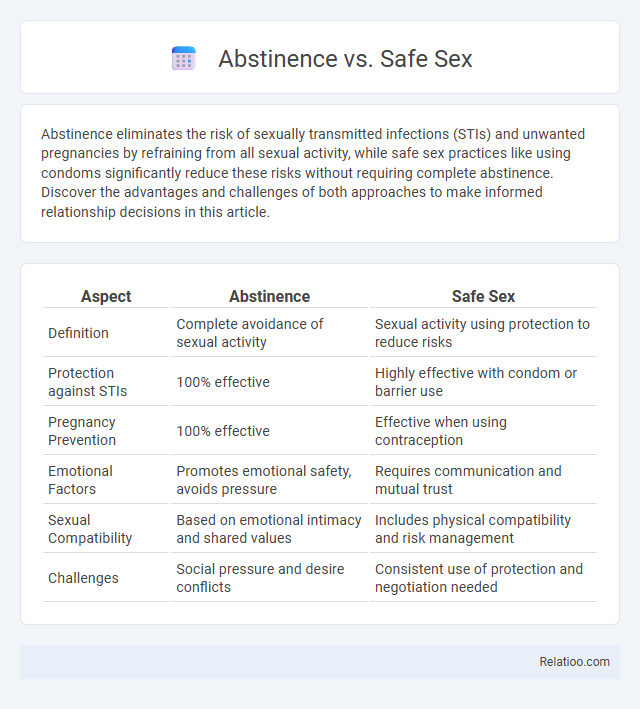Abstinence eliminates the risk of sexually transmitted infections (STIs) and unwanted pregnancies by refraining from all sexual activity, while safe sex practices like using condoms significantly reduce these risks without requiring complete abstinence. Discover the advantages and challenges of both approaches to make informed relationship decisions in this article.
Table of Comparison
| Aspect | Abstinence | Safe Sex |
|---|---|---|
| Definition | Complete avoidance of sexual activity | Sexual activity using protection to reduce risks |
| Protection against STIs | 100% effective | Highly effective with condom or barrier use |
| Pregnancy Prevention | 100% effective | Effective when using contraception |
| Emotional Factors | Promotes emotional safety, avoids pressure | Requires communication and mutual trust |
| Sexual Compatibility | Based on emotional intimacy and shared values | Includes physical compatibility and risk management |
| Challenges | Social pressure and desire conflicts | Consistent use of protection and negotiation needed |
Understanding Abstinence and Safe Sex
Understanding abstinence involves recognizing it as the deliberate choice to refrain from all sexual activity, effectively eliminating risks of pregnancy and sexually transmitted infections (STIs). Safe sex practices, including consistent condom use and regular STI testing, significantly reduce but do not entirely eliminate these risks, offering a practical approach for sexually active individuals. Emphasizing informed decisions and comprehensive sexual education fosters healthier outcomes by balancing the benefits and limitations of both abstinence and safe sex strategies.
Historical Perspectives on Sexual Health
Historical perspectives on sexual health reveal evolving attitudes toward abstinence and safe sex, tracing back to ancient civilizations where abstinence was often linked to religious or moral beliefs. The 20th century marked a significant shift as public health campaigns began promoting safe sex practices, particularly during the HIV/AIDS crisis, emphasizing condom use and sexual education to reduce transmission risks. Debates continue regarding the effectiveness of abstinence-only versus comprehensive safe sex programs, with research supporting the benefits of inclusive education that combines both approaches for improved sexual health outcomes.
Defining Abstinence: Benefits and Challenges
Abstinence refers to the deliberate choice to refrain from all sexual activities, providing 100% effectiveness in preventing sexually transmitted infections (STIs) and unintended pregnancies. Its benefits include eliminating health risks associated with sexual contact and promoting emotional and physical well-being, while challenges often involve social pressure, misinformation, and difficulties in maintaining long-term commitment. Your decision to practice abstinence requires clear communication and personal conviction to navigate these obstacles successfully.
Exploring Safe Sex Practices
Safe sex practices prioritize the consistent use of barrier methods such as condoms to reduce the transmission of sexually transmitted infections (STIs) and prevent unintended pregnancies. Comprehensive sexual education emphasizes communication, consent, and regular health screenings as critical components of effective safe sex strategies. Abstinence, while the only method guaranteeing 100% prevention of STIs and pregnancy, contrasts with safe sex approaches that advocate informed, responsible sexual activity.
Effectiveness in Preventing STIs and Pregnancy
Abstinence is the only 100% effective method in preventing both sexually transmitted infections (STIs) and pregnancy by completely avoiding sexual contact. Safe sex practices, including consistent condom use and other barrier methods, significantly reduce the risk of STIs and unintended pregnancies but do not eliminate them entirely due to potential failure rates. You can maximize protection by combining safe sex methods with regular testing and open communication about sexual health.
Societal and Cultural Influences
Societal and cultural influences significantly shape attitudes toward abstinence, safe sex, and combined approaches, often reflecting prevailing religious beliefs, educational policies, and community norms. In conservative cultures, abstinence is frequently promoted as the preferred method to prevent teenage pregnancy and sexually transmitted infections, while more secular or progressive societies advocate for comprehensive sex education emphasizing safe sex practices. These differing cultural frameworks impact policy-making, access to contraceptives, and public health messaging, ultimately influencing individual sexual behaviors and health outcomes.
Emotional and Psychological Considerations
Emotional and psychological considerations play a crucial role in choosing between abstinence and safe sex, as each approach impacts Your mental well-being differently. Abstinence can provide clarity, reduce anxiety related to sexually transmitted infections (STIs), and align with personal or cultural values, fostering a sense of control and self-respect. Safe sex emphasizes open communication, trust, and responsibility, which can enhance intimacy and emotional security while mitigating fears surrounding sexual health risks.
Myths and Misconceptions
Myths surrounding abstinence often claim it is the only foolproof way to prevent pregnancy and sexually transmitted infections (STIs), but this overlooks the effectiveness of safe sex methods like condoms and contraceptives. Safe sex is frequently misunderstood as promoting promiscuity, yet it primarily focuses on protection and informed choices, empowering you to maintain both physical and emotional health. Misconceptions about abstinence and safe sex can lead to misinformation, so understanding the facts is crucial for making responsible decisions about sexual health.
Educational Approaches and Resources
Educational approaches emphasize comprehensive sex education that covers both abstinence and safe sex practices, providing students with accurate information to make informed decisions. Resources such as school-based programs, online platforms, and healthcare providers offer guidance tailored to individual needs, ensuring Your access to support and factual data. Balancing abstinence-focused curricula with discussions on contraception and disease prevention equips learners with the skills to practice safe behaviors effectively.
Choosing What’s Right for You
Choosing between abstinence and safe sex depends on your personal values, health goals, and lifestyle. Abstinence eliminates the risk of sexually transmitted infections (STIs) and unintended pregnancies, while safe sex practices, including consistent condom use and regular testing, significantly reduce these risks without forgoing intimacy. Evaluating your comfort level and priorities helps you make the best decision for your sexual health and well-being.

Infographic: Abstinence vs Safe Sex
 relatioo.com
relatioo.com